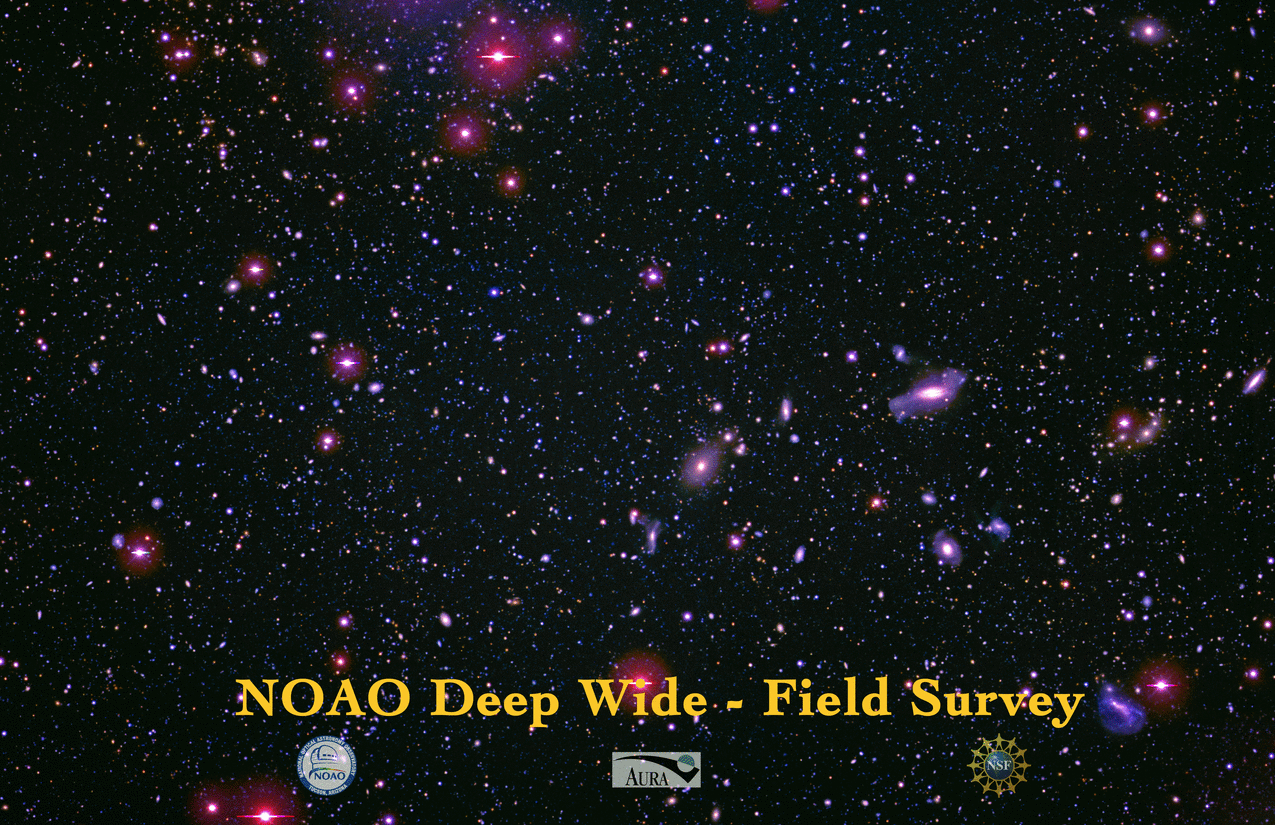
 |
| Home Data-Access Data-Processing NDWFS-Publications Related-Surveys Links Additional-Documentation |

|
The picture above is a small region from the third NDWFS data release (DR3). |
(12/12/2005) The optical and X-ray catalogs from the XBoötes Survey can be obtained through the above link, and by 12/13/2005, through the NOAO Science Archive. The XBoötes Survey is a 5-ks Chandra survey of the Boötes Field of the NOAO Deep Wide-Field Survey ( Murray et al. 2005 ). The catalog presents the 3,213 X-ray point-source in the XBoötes survey (reproduced from Kenter et al. 2005), and the matched optical and near-IR properties from the NDWFS DR3. The optical and near-IR catalog of the X-ray point sources is presented in Brand et al. 2006 (ApJ, in press, PDF version of paper). The catalogs are matched using a Bayesian identification scheme (see Brand et al. (2006) for details). All optical sources with >1% probability of being the match to an X-ray source are included. To select only the most probable optical counterpart (including no optical counterpart), one should select only the sources with optical rank=1.
At the above link, or through the NOAO Science Archive, you will find all of the processed optical MOSAIC-1 and ONIS IR images obtained of our 9.3 square degree Boötes field. You will also find single band catalogues. Multi-band matched catalogues, as well as additional IR imaging (using FLAMINGOS) will be made available in the near future. These images and catalogues comprise our third NDWFS data release. Full documentation of these data sets will be included in two papers under preparation and on the linked web pages. The content of the web pages documenting the release will continue to be expanded over the next few weeks.
The 1st semester field (we call this the Boötes Field) is a 3x3 degree region
near the North Galactic Pole, centered on approximately
A giff format image of the POSS DSS data of the 1st semester (Boötes) field location is
shown here.
A giff format image of the POSS DSS data of the 2nd semester (Cetus; equatorial) field location is
shown here.
Optical pointing coordinates of subfields in both Deep Wide-Field Survey fields are given here.
Documentation of the achieved depths for the Boötes field will be presented in Jannuzi et al. 2005 (in preparation, for the optical imaging) and Dey et al. 2005 (in preparation, for the IR imaging) and off of the link for the October 22, 2004 data release above.
| 5-sig Detection Limit in 2" Aperture |
1-sig Surf. Brightness Limit per square arcsec |
|||
|---|---|---|---|---|
| Bands | AB mag. | Vega mag. | AB mag. | Vega mag. |
| BW | 26.6 | 26.6 | 29.0 | 29.0 |
| R | 26.0 | 25.8 | 28.4 | 28.2 |
| I | 26.0 | 25.5 | 28.4 | 27.9 |
| J | 21.0 | 20.2 | 23.4 | 22.6 |
| H | 21.0 | 19.6 | 23.4 | 22.0 |
| K | 21.4 | 19.5 | 23.8 | 21.9 |
Optical pointing coordinates of the subfields in both Deep Wide-Field Survey fields are given here.
Buell Jannuzi,
Arjun Dey (Survey Co-PI's),
Taft Armandroff,
Ed Ajhar (St. Thomas University),
Bob Blum,
Todd Boroson,
Kate Brand,
Michael J. I. Brown (Monash University),
Chuck Claver,
Lindsey Davis (NRAO),
Ian Dell'Antonio (Brown),
Mark Dickinson,
Richard Elston (U. of Fla., deceased),
Alyson Ford (Swinburne)
Richard F. Green,
Pat Hall (York),
Emma Hogan (Leicester)
George Jacoby (GMT),
Dick Joyce,
Tod Lauer,
Roger Lynds,
Sangeeta Malhotra (ASU),
Mike Merrill,
Lissa Miller (Yale),
Joan Najita,
Dara Norman,
Earl O'Neil (Steward),
Marc Postman (STScI),
Ron Probst,
Travis Rector (University of Alaska),
James Rhoads (STScI),
Erin Ryan (SSC),
Robert Schommer (deceased),
Nigel Sharp (NSF),
Malcolm Smith,
Paul S. Smith (Steward),
Glenn Tiede (BGSU),
Frank Valdes,
Jeff Valenti (STScI),
Ted von Hippel (UofTexas),
Alistair Walker,
and Sidney Wolff.